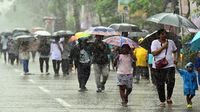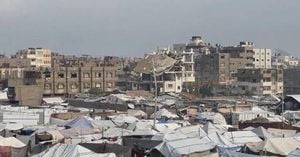As August 2025 draws on, India’s western and northern cities are experiencing a dramatic turn in their monsoon weather, with Mumbai and Chandigarh each facing their own challenges and moments of relief. The India Meteorological Department (IMD) has issued a series of weather alerts across Maharashtra and the north, warning citizens and authorities to brace for heavy rainfall, gusty winds, and the cascading effects these conditions can have on daily life. The atmosphere is a curious mix of tension and celebration, as festivals continue even while the skies darken.
In Mumbai, the IMD put the city on an orange alert on Sunday, August 17, 2025, forecasting heavy to very heavy rainfall at a few locations across the city and its sprawling suburbs. Neighboring districts Thane and Palghar also found themselves under the same warning, with the alert set to last at least through Tuesday, August 19. The message from officials is clear: stay vigilant as the monsoon’s intensity shows no signs of abating. According to Mint, the IMD’s forecast included the possibility of gusty winds reaching 40 to 50 kilometers per hour, with gusts up to 60 kilometers per hour—a force strong enough to sway even the hardiest of Mumbai’s trees.
The numbers tell the story. Mumbai city recorded 22.55 mm of rainfall on Sunday morning, with the eastern and western suburbs logging 24.18 mm and 17.48 mm respectively. But these figures only scratch the surface. In the 24-hour period ending at 8 am Sunday, the city saw widespread rainfall totaling 92.81 mm, with the western suburbs registering a remarkable 103.98 mm and the eastern suburbs 78.15 mm. The Colaba observatory reported a high of 26.8°C and a low of 24°C, while the Santacruz observatory noted a maximum of 26.3°C and minimum of 24°C.
Heavy rain inevitably brings disruption to a city as vast and densely populated as Mumbai. Local trains on the Central Railway route ran slightly late on Sunday morning, though authorities didn’t specify a reason. The city’s lifelines—the local trains—are often the first to feel the strain when the monsoon flexes its muscles. Meanwhile, as reported by ANI, over 350 flights were diverted amid the unfavorable weather conditions, with airlines like IndiGo and Akasa Air issuing advisories urging passengers to leave earlier than usual and keep a close eye on their flight status.
But the rain’s impact wasn’t limited to transportation. The Brihanmumbai Municipal Corporation (BMC) announced that Tulsi Lake, one of the seven reservoirs supplying drinking water to the metropolis, began overflowing at 6:45 pm on Saturday, August 16. The lake, situated in the Sanjay Gandhi National Park, hit its maximum storage capacity of 804.60 crore liters, and with its usable storage now full, excess water started flowing out. The BMC data revealed that the combined stock in the seven reservoirs providing water to Mumbai stood at a robust 90.68 percent as of August 17—a rare silver lining for a city often anxious about water shortages by the end of summer.
Yet, the deluge brought hazards as well. The water level in the Mithi River rose following the incessant rainfall, prompting officials to keep a close watch for potential flooding. Waterlogging was observed in several parts of the city, including Mahim and the Chunabhatti area, forcing residents to wade through knee-deep water. In Thane, tree branches and even walls gave way under the relentless downpour, with civic officials reporting six short circuits, 19 tree or branch falls, and two wall collapse incidents. Fortunately, no injuries were reported from these specific incidents, though the risk remains high with the IMD forecasting more rain and strong winds through August 21.
Elsewhere in Maharashtra, the IMD issued a red alert for Palghar, Raigad, and Ratnagiri, warning of extremely heavy rainfall at isolated places. The State Emergency Operations Centre notified the likelihood of heavy rainfall accompanied by strong winds across the state from August 16 to August 21, with some areas in the Konkan and the ghats of Central Maharashtra expected to witness exceptionally intense showers. Lightning, thunder, and winds up to 50 km/h could add to the hazards.
The rain-soaked weekend also coincided with the vibrant Dahi Handi celebrations, marking Krishna Janmashtami. Spells of heavy showers failed to dampen the spirit of festival-goers, with teams forming human pyramids across Mumbai, even as water streamed down streets and over temple steps. However, the celebrations were marred by tragedy: as reported by PTI, 95 people were injured and two deaths were recorded in Mumbai due to accidents related to the event. A 32-year-old man died on Saturday in Mankhurd while tying the Dahi Handi rope, and at least nine children, some as young as five, were injured in Thane. In Vikhroli Parksite, a landslide claimed two lives in the early hours of Sunday, a grim reminder of the risks posed by saturated ground and unstable slopes. "We are sleeping in our home, when suddenly around 2.30 am debris collapsed on one of the houses and a family was trapped," a resident recounted to HT.
Further afield, in Himayatnagar tehsil, four cattle drowned in floodwaters, with some villages cut off and 20 houses flooded as of August 17. Central Maharashtra’s Nanded district also reported three deaths in rain-related incidents over the last two days, as rivers and streams surged beyond their banks.
Meanwhile, in Chandigarh, the weather narrative was less dramatic but still noteworthy. On Saturday, August 16, the maximum temperature dipped slightly to 33.5°C from Friday’s 33.7°C, while the minimum rose from 24.9°C to 25.8°C. The IMD issued a yellow alert for Sunday and Monday, flagging the chance of heavy rain at isolated places. The department forecast that cloudy conditions would persist until Thursday, August 21, and predicted a further drop in temperatures to a maximum of 31°C and a minimum of 25°C by Tuesday. Walkers at Sukhna Lake enjoyed the relative coolness, even as city authorities kept a wary eye on water levels.
Indeed, the Sukhna flood gates had to be opened for the third time this season on Friday evening, August 15, as the lake’s water level neared the danger mark of 1,163 feet. The gates were closed around 3 am Saturday after the level dropped to 1,162.5 feet, following the release of excess water into the Sukhna Choe. Previous openings had occurred earlier in the month, on August 6 and 8, underscoring the season’s persistent rainfall.
As the monsoon continues to shape life across India’s cities, the resilience of communities is on full display—from festival crowds braving the rain in Mumbai to early-morning walkers at Sukhna Lake in Chandigarh. But with more rain on the horizon and alerts still in effect, the coming days will test both infrastructure and spirit in equal measure.




